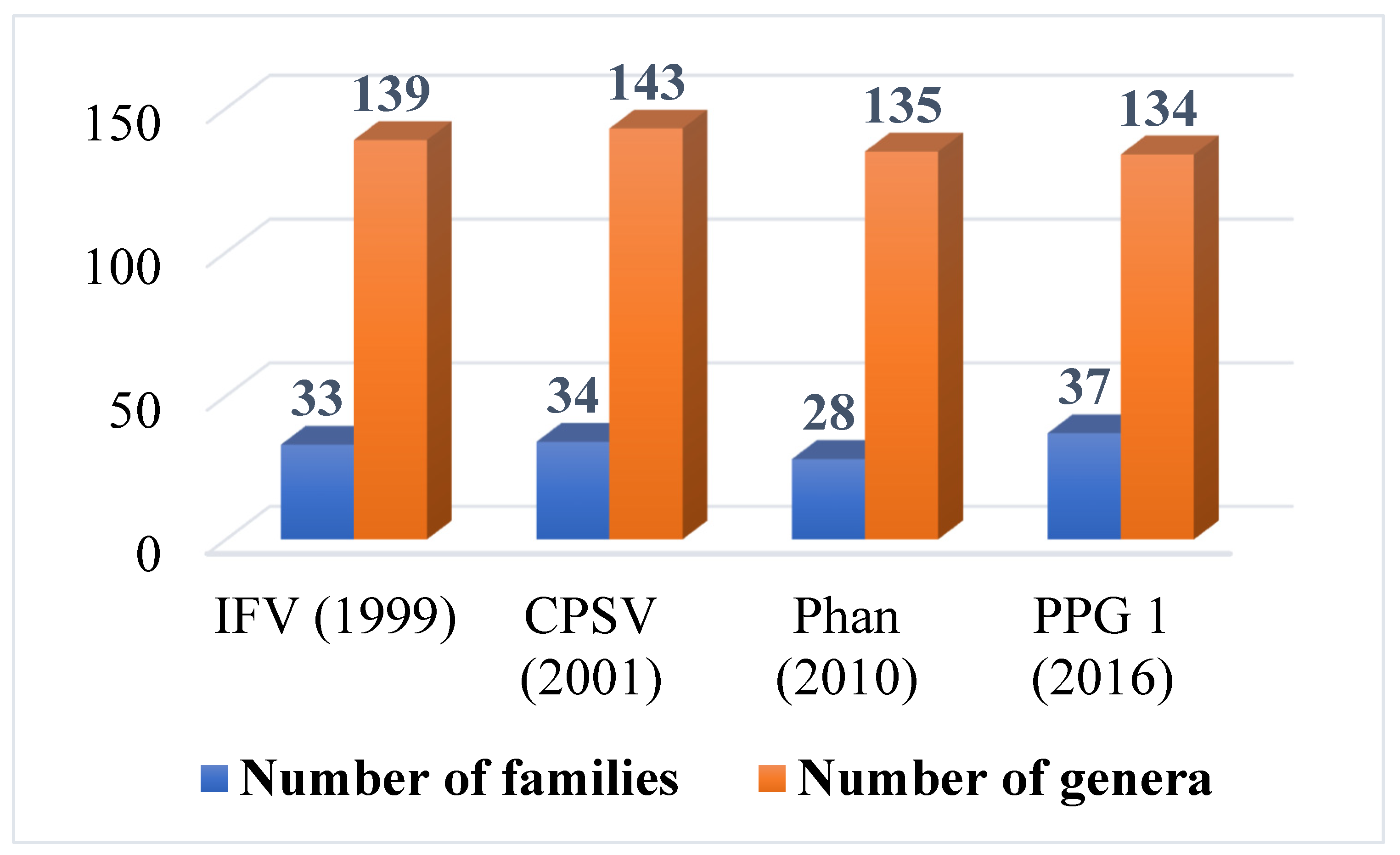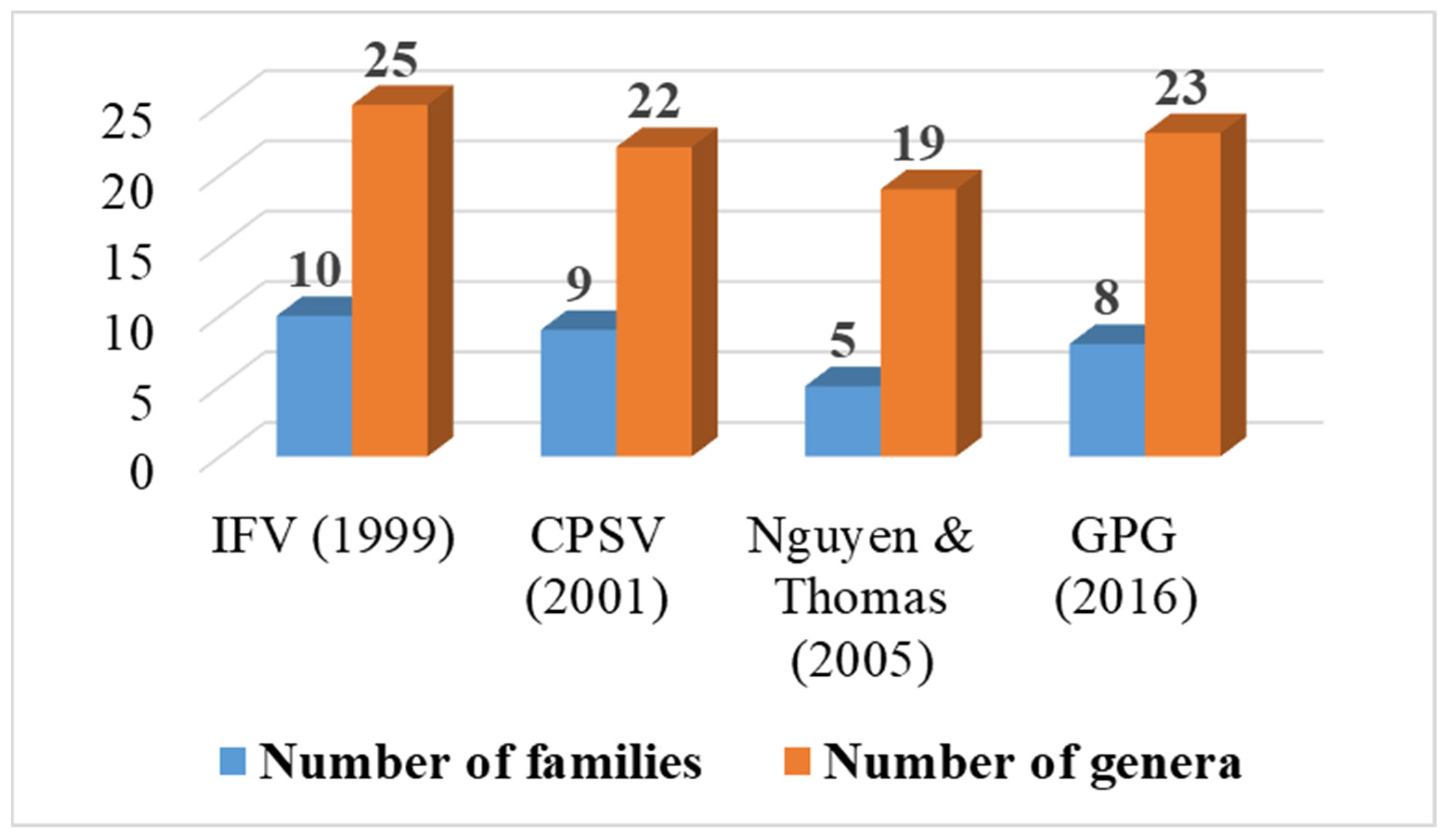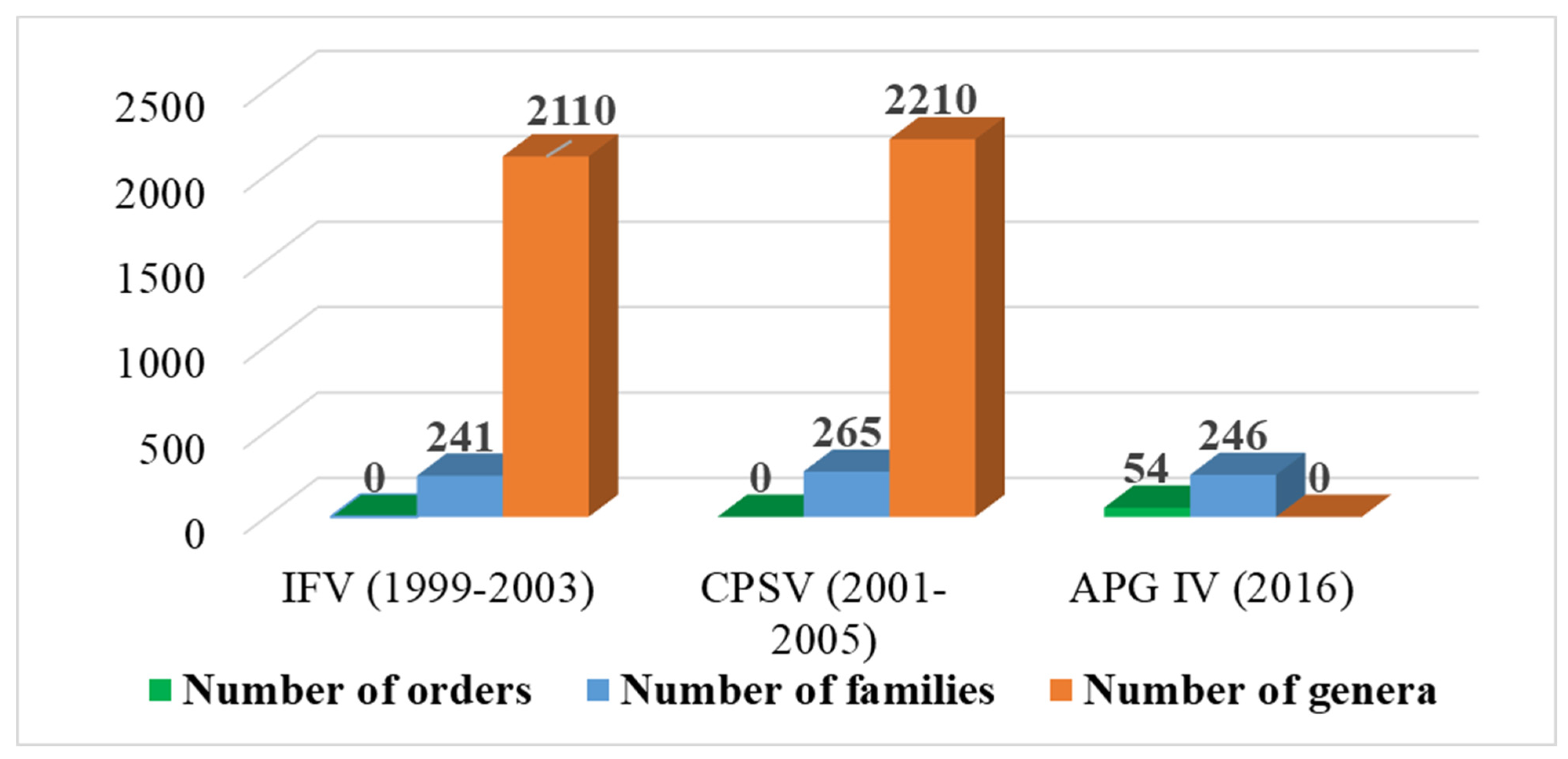Classification of Vascular Plants in Vietnam According to Modern Classification Systems
Abstract
1. Introduction
2. Results and Discussion
2.1. History of Classification of Vascular Plants in Vietnam
2.2. Classification of Vascular Plants of Vietnam according to Modern Classification Systems
2.2.1. Lycophytes and Ferns
2.2.2. Gymnosperms
2.2.3. Angiosperms
3. Materials and Methods
4. Conclusions
Supplementary Materials
Author Contributions
Funding
Data Availability Statement
Acknowledgments
Conflicts of Interest
References
- Zhang, L.B.; Gilbert, M.G. Comparison of classifications of vascular plants of China. Taxon 2015, 64, 17–26. [Google Scholar] [CrossRef]
- Nguyen, B.T. Checklist of Plant Species of Vietnam; Agriculture Publishing House: Hanoi, Vietnam, 2001–2005; Volume 1–3. [Google Scholar]
- Zhu, H.; Qin, H.; Yan, L. Floristic Composition and Characteristics of Vietnamese Flora. Acta Sci. Nat. Univ. Sunyatseni 2003, 42, 98–102. [Google Scholar]
- Stuessy, T.F. Plant Taxonomy. The Systematic Evolution of Comparative Data, 2nd ed.; Columbia University Press: New York, NY, USA, 2009. [Google Scholar]
- APG. An ordinal classification for the families of flowering plants. Ann. Mo. Bot. Gard. 1998, 85, 531–553. [Google Scholar] [CrossRef]
- APG II. An update of the Angiosperm Phylogeny Group classification for the orders and families of flowering plants: APG II. Bot. J. Linn. Soc. 2003, 141, 399–436. [Google Scholar] [CrossRef]
- APG III. An update of the Angiosperm Phylogeny Group classification for the orders and families of flowering plants: APG III. Bot. J. Linn. Soc. 2009, 161, 105–121. [Google Scholar] [CrossRef]
- APG IV. An update of the Angiosperm Phylogeny Group classification for the orders and families of flowering plants: APG IV. Bot. J. Linn. Soc. 2016, 181, 1–20. [Google Scholar] [CrossRef]
- The Pteridophyte Phylogeny Group: PPG 1. A community-derived classification for extant lycophytes and ferns. J. Syst. Evol. 2016, 54, 563–603. [Google Scholar] [CrossRef]
- Christenhusz, M.J.M.; Reveal, J.L.; Farjon, A.; Gardner, M.F.; Mill, R.R.; Chase, M.W. A new classification and linear sequence for extant gymnosperms. Phytotaxa 2011, 19, 55–70. [Google Scholar] [CrossRef]
- De Loureiro, J. Flora Cochinchinensis; Ulyssipone: Typis, et Expenses Academicis: Paris, France, 1790; Volume 1–2. [Google Scholar]
- Gagnepain, F.; Humbert, H.; Lecomte, H. Flore généRale de l’Indo-Chine; Muséum National d’Histoire Naturelle: Paris, France, 1907. [Google Scholar] [CrossRef]
- Editorial Committee of Flore du Cambodge, du Laos et du Viêtnam (Ed.) Flore du Cambodge, du Laos et du Viêtnam; Muséum National d’Histoire Naturelle: Paris, France, 1960–2004; Volume 1–32. [Google Scholar]
- Pham, H.H. An Illustrated Flora of South Vietnam (Cây cỏ miền Nam Việt Nam), 1st ed.; Education Publishing House: Saigon, Vietnam, 1969. [Google Scholar]
- Pham, H.H. An Illustrated Flora of South Vietnam (Cây cỏ miền Nam Việt Nam), 2nd ed.; Education Publishing House: Saigon, Vietnam, 1970–1972; Volume 1–2. [Google Scholar]
- Pham, H.H. An Illustrated Flora of Vietnam (Cây cỏ Việt Nam), 1st ed.; Mekong Publishing House: Santa Ana, CA, USA; Montreal, QC, Canada, 1991–1993; Volume 1–3. [Google Scholar]
- Pham, H.H. An Illustrated Flora of Vietnam (Cây cỏ Việt Nam), 2nd ed.; Young Publishing House: Ho Chi Minh City, Vietnam, 1999–2003; Volume 1–3. [Google Scholar]
- Nguyen, B.T. Handbook to Reference and Identification of the Families of Angiospermae Plants in Vietnam; Agricultural Publishing House: Hanoi, Vietnam, 1997. [Google Scholar]
- Pierre, J.B.L. Flore Forestiere de la Cochinchine; Octave Doin: Paris, France, 1880–1907; Volume 1–4. [Google Scholar]
- Bentham, G.; Hooker, J.D. Genera Plantarum; Reeve: London, UK, 1867. [Google Scholar]
- Middleton, D.J. Apocynaceae. In Flora of Cambodia, Laos, and Vietnam; Royal Botanic Gardens Edinburgh: Edinburgh, UK, 2014; Volume 33. [Google Scholar]
- Pendry, C.A. Polygalaceae. In Flora of Cambodia, Laos, and Vietnam; Royal Botanic Gardens Edinburgh: Edinburgh, UK, 2014; Volume 34. [Google Scholar]
- Hul, S.; Phon, P.D. Solanaceae. In Flora of Cambodia, Laos, and Vietnam; Royal Botanic Gardens Edinburgh: Edinburgh, UK, 2014; Volume 35. [Google Scholar]
- Staples, G.W. Solanaceae. In Flora of Cambodia, Laos, and Vietnam; Royal Botanic Gardens Edinburgh: Edinburgh, UK, 2018; Volume 36. [Google Scholar]
- Cronquist, A. An Integrated System of Classification of Flowering Plants; Columbia University Press: New York, NY, USA, 1981. [Google Scholar]
- Melchior, H. Engler’s Syllabus Der Pflanzenfamilien; Gerbruder Borntraeger: Berlin, Germany, 1964. [Google Scholar]
- Takhtajan, A. Evolution un Ausbreitung der Blutenpflanzen; Zena: Washington, DC, USA, 1973. [Google Scholar]
- Takhtajan, A. Systema Magnoliophytorum; Izd-vo Nauka: Leningrad, Russia, 1987. [Google Scholar]
- Takhtajan, A. Diversity and Classification of Flowering Plants; Columbia University Press: New York, NY, USA, 1996. [Google Scholar]
- Nguyen, B.T. Annonaceae. In Flora of Vietnam; Science and Technics Publishing House: Hanoi, Vietnam, 2000; Volume 1. [Google Scholar]
- Vu, P.X. Lamiaceae. In Flora of Vietnam; Science and Technics Publishing House: Hanoi, Vietnam, 2000; Volume 2. [Google Scholar]
- Nguyen, K.K. Cyperaceae. In Flora of Vietnam; Science and Technics Publishing House: Hanoi, Vietnam, 2002; Volume 3. [Google Scholar]
- Tran, K.T. Myrsinaceae. In Flora of Vietnam; Science and Technics Publishing House: Hanoi, Vietnam, 2002; Volume 4. [Google Scholar]
- Tran, L.D. Apocynaceae. In Flora of Vietnam; Science and Technics Publishing House: Hanoi, Vietnam, 2007; Volume 5. [Google Scholar]
- Vu, P.X. Verbenaceae. In Flora of Vietnam; Science and Technics Publishing House: Hanoi, Vietnam, 2007; Volume 6. [Google Scholar]
- Le, B.K. Asteraceae. In Flora of Vietnam; Science and Technics Publishing House: Hanoi, Vietnam, 2007; Volume 7. [Google Scholar]
- Nguyen, D.T. Liliales. In Flora of Vietnam; Science and Technics Publishing House: Hanoi, Vietnam, 2007; Volume 8. [Google Scholar]
- Duong, H.D. Orchidaceae-Dendrobium. In Flora of Vietnam; Science and Technics Publishing House: Hanoi, Vietnam, 2007; Volume 9. [Google Scholar]
- Nguyen, T.V. Chlorophyta. In Flora of Vietnam; Science and Technics Publishing House: Hanoi, Vietnam, 2007; Volume 10. [Google Scholar]
- Nguyen, D.H. Fucales. In Flora of Vietnam; Science and Technics Publishing House: Hanoi, Vietnam, 2007; Volume 11. [Google Scholar]
- Ha, T.M. Sapindaceae. In Flora of Vietnam; Publishing House for Science and Technology: Hanoi, Vietnam, 2017; Volume 12. [Google Scholar]
- Tran, A.P.T. Arecaceae. In Flora of Vietnam; Publishing House for Science and Technology: Hanoi, Vietnam, 2017; Volume 13. [Google Scholar]
- Do, X.T. Malvaceae. In Flora of Vietnam; Publishing House for Science and Technology: Hanoi, Vietnam, 2017; Volume 14. [Google Scholar]
- Tran, B.T. Asclepiadaceae. In Flora of Vietnam; Publishing House for Science and Technology: Hanoi, Vietnam, 2017; Volume 15. [Google Scholar]
- Nguyen, D.V. Araceae. In Flora of Vietnam; Publishing House for Science and Technology: Hanoi, Vietnam, 2017; Volume 16. [Google Scholar]
- Vu, H.V.; Vu, P.X. Solanaceae, and Loganiaceae. In Flora of Vietnam; Publishing House for Science and Technology: Hanoi, Vietnam, 2017; Volume 17. [Google Scholar]
- Vu, P.X. Gesneriaceae. In Flora of Vietnam; Publishing House for Science and Technology: Hanoi, Vietnam, 2017; Volume 18. [Google Scholar]
- Nguyen, H.H. Theaceae. In Flora of Vietnam; Publishing House for Science and Technology: Hanoi, Vietnam, 2017; Volume 19. [Google Scholar]
- Nguyen, D.K. Lauraceae. In Flora of Vietnam; Publishing house for Science and Technology: Hanoi, Vietnam, 2017; Volume 20. [Google Scholar]
- Nguyen, B.Q. Zingiberaceae. In Flora of Vietnam; Publishing House for Science and Technology: Hanoi, Vietnam, 2017; Volume 21. [Google Scholar]
- Brummitt, R.K. Vascular Plants Families, and Genera; Royal Botanic Gardens, Kew: Melbourne, VIC, Australia, 1992. [Google Scholar]
- Smith, A.R.; Pryer, K.M.; Schuettpelz, E.; Korall, P.; Schneider, H.; Wolf, P.G. A classification for extant ferns. Taxon 2016, 55, 705–731. [Google Scholar] [CrossRef]
- Phan, K.L. The updated checklist of the fern flora of Vietnam following the classification scheme of A. Smith et al. (2006). J. Fairylake Bot. Gard. 2010, 9, 1–13. [Google Scholar]
- Metzgar, J.S.; Schneider, H.; Pryer, K.M. Phylogeny and divergence time estimates for the fern genus Azolla (Salviniaceae). Int. J. Plant Sci. 2007, 168, 1045–1053. [Google Scholar] [CrossRef]
- Choo, T.Y.S.; Escapa, I.H. Assessing the evolutionary history of the fern family Dipteridaceae (Gleicheniales) by incorporating both extant and extinct members in a combined phylogenetic study. Am. J. Bot. 2018, 105, 1315–1328. [Google Scholar] [CrossRef] [PubMed]
- Kim, C.; Zha, H.-G.; Deng, T.; Sun, H.; Wu, S.-G. The phylogenetic position of Kontumia (Polypodiaceae) was inferred from four chloroplast DNA regions. J. Syst. Evol. 2012, 51, 154–163. [Google Scholar] [CrossRef]
- Zhang, L.; Lu, N.T.; Zhou, X.-M.; Chen, D.-K.; Knapp, R.; Zhou, L.; Guo, L.; Luong, T.T.; Sun, H.; Gao, X.-F.; et al. A plastid phylogeny of the Old World fern genus Leptochilus (Polypodiaceae): Implications for cryptic speciation and taxonomy. Mol. Phylogenetics Evol. 2019, 134, 311–322. [Google Scholar] [CrossRef] [PubMed]
- Cheng, Y.; Nicolson, R.G.; Tripp, K.; Chaw, S.M. Phylogeny of Taxaceae and Cephalotaxaceae genera inferred from chloroplast matK gene and nuclear rDNA ITS region. Mol. Phylogenetics Evol. 2000, 14, 353–365. [Google Scholar] [CrossRef] [PubMed]
- Thomas, P.; Luu, N.D.T.; Gardner, M.; Dick, J.; Ingieby, K.; Canh, N.D.; Thanh, V.T.X. Darwin Initiative for the Survival of Species—Final Report 162/10/017. Preservation, Rehabilitation and Utilisation of Vietnamese Montane Forests. 2004. Available online: https://nora.nerc.ac.uk/id/eprint/502392/1/N502392CR.pdf (accessed on 5 October 2022).
- Farjon, A. A monograph of Cupressaceae and Sciadopitys; Royal Botanic Gardens, Kew: Melbourne, VIC, Australia, 2005. [Google Scholar]
- Wickett, N.J.; Mirarab, S.; Nguyen, N.; Warnow, T.; Carpenter, E.; Matasci, N.; Ayyampalayam, S.; Barker, M.S.; Burleigh, J.G.; Gitzendanner, M.A.; et al. Phylotranscriptomic analysis of the origin and early diversification of land plants. Proc. Natl. Acad. Sci. USA 2014, 111, E4859–E4868. [Google Scholar] [CrossRef] [PubMed]
- Stevens, P.F. Angiosperm Phylogeny Website, Version 14. July 2017. Available online: http://www.mobot.org/MOBOT/research/APweb/ (accessed on 5 October 2022).



Disclaimer/Publisher’s Note: The statements, opinions and data contained in all publications are solely those of the individual author(s) and contributor(s) and not of MDPI and/or the editor(s). MDPI and/or the editor(s) disclaim responsibility for any injury to people or property resulting from any ideas, methods, instructions or products referred to in the content. |
© 2023 by the authors. Licensee MDPI, Basel, Switzerland. This article is an open access article distributed under the terms and conditions of the Creative Commons Attribution (CC BY) license (https://creativecommons.org/licenses/by/4.0/).
Share and Cite
Luu-dam, N.A.; Lu, N.T.; Pham, T.H.; Do, T.V. Classification of Vascular Plants in Vietnam According to Modern Classification Systems. Plants 2023, 12, 967. https://doi.org/10.3390/plants12040967
Luu-dam NA, Lu NT, Pham TH, Do TV. Classification of Vascular Plants in Vietnam According to Modern Classification Systems. Plants. 2023; 12(4):967. https://doi.org/10.3390/plants12040967
Chicago/Turabian StyleLuu-dam, Ngoc A., Ngan T. Lu, Thai H. Pham, and Truong V. Do. 2023. "Classification of Vascular Plants in Vietnam According to Modern Classification Systems" Plants 12, no. 4: 967. https://doi.org/10.3390/plants12040967
APA StyleLuu-dam, N. A., Lu, N. T., Pham, T. H., & Do, T. V. (2023). Classification of Vascular Plants in Vietnam According to Modern Classification Systems. Plants, 12(4), 967. https://doi.org/10.3390/plants12040967





